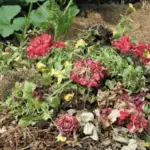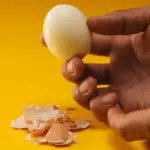What about composting? Can you compost weeds? Anyone with a garden has weeds. The invasive plants seem to appear as soon as you walk away. In one season, you pull an amazing amount of weeds.
Tossing plant debris in the trash is one solution. Weeds naturally decompose, so your garbage is an eco-friendly way to dispose of unwanted plants.
You can compost weeds and other plant debris like leaves and grass clippings. Weeds can provide necessary nutrients, but they can also cause problems in compost.

What Are the Issues with Composting Weeds?
Weeds and other plant matter comprise the green layers in a compost pile. These layers provide nitrogen, while the brown take care of creating carbon.
Nitrogen is essential to support healthy plant growth and a long blooming season. The only problem with composting weeds is they may resprout in your garden.
It’s exciting when a tomato plant pops up unexpectedly in the garden. Pumpkins tossed into compost after Halloween are also known to return the following season.
It’s different when last year’s weeds start regrowing. Known as volunteer plants, they occur when seeds or roots survive composting.

How Weeds Survive Composting?
Successfully composting weeds depends on the pile’s internal temperature. As the plant material breaks down, it generates heat.
To ensure all of the seeds and roots from weeds decompose the internal temperature needs to be at least 145 degrees Fahrenheit. Any lower, and the seeds or roots can regerminate in your garden.
Frequently aerating the compost pile and alternating between brown and green layers will help increase the temperature. Don’t forget to moisten each layer.
It speeds up decomposition, which generates heat. Another tip is to build your compost pile in a sunny location.

How Do You Compost Weeds?
Composting weeds uses the same method as other garden waste. The weeds go in the green layer, and from there, you can use either hot or cold composting. Both methods are effective and will prevent weeds in compost from reappearing in the garden.
Hot Composting
Often referred to as the classic method, hot composting means the pile’s internal temperature is always at or above 145 degrees Fahrenheit. It takes a little extra work, but it’s worth it when you aren’t spending hours weeding your garden.
Hot composting weeds consist of three simple steps.
- Aerate the pile every three or four days. Oxygen is necessary for decomposition. Compost piles can also develop cool zones causing the plant material to break down slower.
- Do not add new plant material to a hot compost pile. It slows down decomposition, and the pile may not be ready for garden use by spring. Starting a new pile also ensures a constant supply of organic garden fertilizer.
- Before applying the compost, give your garden a good weeding. The compost is packed with nutrients weeds will use to thrive. It’s easier to pull up weak weeds, instead of strong, healthy ones with fully developed root systems.
Even though hot composting takes some work, it’s an extremely effective way to ensure weeds don’t return.
Cold Composting
Unlike hot composting, which requires frequent moisture and aerating, cold composting is a more laidback method.
You don’t have to monitor the pile’s internal temperature, and you can keep adding material to the compost. Cold composting is a great option for anyone that doesn’t have the space for a second pile.
How cool composting works is simple. As you are adding plant material to the top, the bottom layers are breaking down.
When it’s time to fertilize, you remove the compost from the bottom of the pile.
Cold composting is easy. All you do is add layers of organic material to your compost, but it also takes longer for the materials to decompose.
There are also some weeds you do not want to put in cold compost. They may not break down and can regrow in the garden.

Which Weeds Shouldn’t You Put In Cold Compost?
Cold composting is an effective way to break down most weeds, but some may not fully decompose.
- Pernicious weeds: Perennial weeds often require plenty of heat before they break down past the point of regrowth. If you don’t want to start a hot composting pile, these weeds are better off in the trash. Some weeds you don’t want to cold compost include crab and quack grasses. Oxalis, buttercups and other garden weeds which are spread by runners belong in a hot composting pile.
- Weeds that have started seeding: You can toss most annual weeds like dandelions in a cold compost pile, as long as the flowerhead isn’t producing seeds. Once weeds have gone to seed, keep them out of your cold compost. The seeds won’t break down, allowing the weeds to return after fertilizing the plants.

Bake the Weeds Before Putting Them in Compost
Don’t worry, you aren’t going to put the weeds in the oven to bake. You can easily do it outdoors in the sun.
Find a sunny spot out of the way and lay the weeds out on a metal sheet. It only takes a few days in the sun before the weeds are dried and brown. When the weeds crumble in your hands, the weeds and roots are no longer viable.
Another option is to solar-bake the weeds. All you need is a black, plastic trash bag and a sunny location. Leave the weeds in the bag for three or four days, before adding them to the compost.
It’s also not unheard of for avid composters to keep an old microwave in the garage, specifically for baking weeds. Instead of a few days, it only takes seconds in the microwave.
Conclusion
You can put weeds in compost. It’s a great way to add nutrients to the pile. If you are hot composting, all weeds can go in the heap. It’s a little different with cold composting.
Some runner weeds may not break down, and it means you will spend more time weeding your garden.






